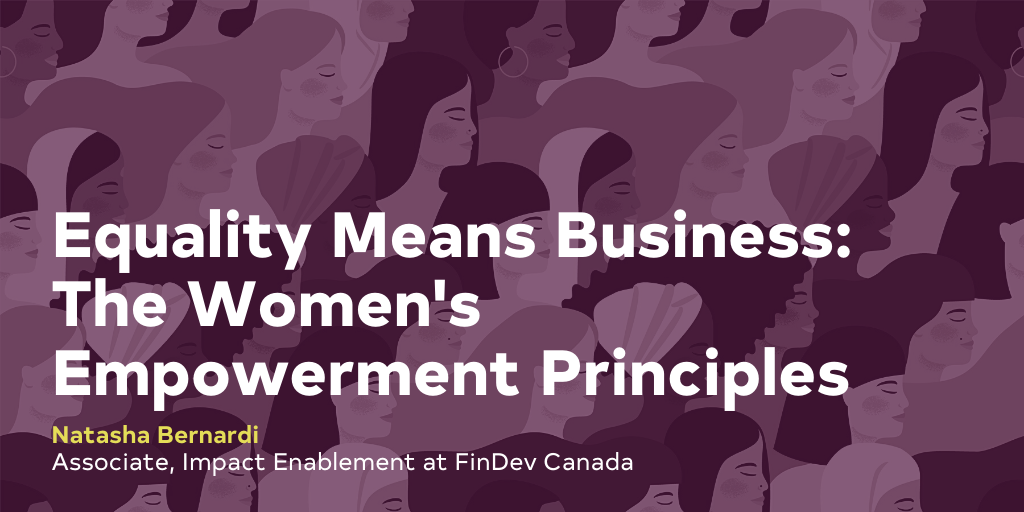By: Natasha Bernardi, Impact Associate
It was just over a decade ago, on International Women’s Day in 2010, that UN Women and UN Global Compact collaborated to establish and launch the Women’s Empowerment Principles (WEPs). The idea behind them was, and remains, simple: to offer clear and practical guidance to businesses worldwide as they seek to advance gender equality and empower women in the workplace, marketplace, and community. The WEPs also serve to help governments as they engage with businesses to promote gender equality in all aspects of society.
In their elaboration, the WEPs are a broad set of best practices that each organization is called upon to implement:
- Principle 1: Establish high-level corporate leadership for gender equality;
- Principle 2: Treat all women and men fairly at work – respect and support human rights and non-discrimination;
- Principle 3: Ensure the health, safety, and well-being of all women and men workers;
- Principle 4: Promote education, training, and professional development for women;
- Principle 5: Implement enterprise development, supply chain and marketing practices that empower women;
- Principle 6: Promote equality through community initiatives and advocacy; and
- Principle 7: Measure and publicly report on progress to achieve gender equality.
Since 2010, more than 3,400 companies and organizations worldwide have become signatories to the Women’s Empowerment Principles and adopted their subtitle motto: Equality Means Business. Each of these companies, whether private, public, state-owned, or a cooperative, including industry associations or chambers of commerce, undertakes to treat women and men equally in every aspect of its activities.
For companies, this is more than corporate social responsibility. Gender equality at all levels of the organization has proven to be good for business - more and more evidence demonstrates a strong correlation between gender equality and superior business results in terms of productivity, profitability and economic growth. A publication from Financial Times, featuring a study from MCSI on over 600 companies worldwide, noted that companies with best practice standards in human capital management that also have a gender-diverse board delivered higher productivity growth over the same period. In fact, a recent report from IDB Invest presented a regional analysis, which covered 345 companies in Latin America, where companies with higher representation of women yielded return on investments that were 44% higher.
It Begins With Commitment
Signatories of the Women’s Empowerment Principles are on a journey to achieving substantive gender equality, women’s empowerment, and sustainable development. The starting point for each journey is the CEO Statement of Support, committing the organization to adopt the seven Principles. In doing so, each signatory firm acknowledges the changes and benefits that they will:
- Bring the broadest pool of talent to an organization’s endeavors;
- Further its competitiveness;
- Help to meet its corporate responsibility and sustainability commitments;
- Model behavior within the company that reflects the society it would like for its employees, their families, and their fellow citizens;
- Encourage economic and social conditions that provide equal opportunities for women and men; and
- Foster sustainable development in the countries in which it operates.
To help companies in their journey, the WEPs offer a Gender Gap Analysis Tool. This is a free, user-friendly online platform that serves as a great introduction to the many dimensions of gender equality. The tool provides guidance for companies to self-assess their strengths and weaknesses in terms of gender equality and helps businesses establish a starting point against which to measure progress, with clearly defined benchmarks that outline and recognize accomplishments over time. The tool is a great way to nudge organizations in moving from commitment to action.
According to a recent report by UN Global Compact and BSR, organizations working in Financial Services sectors are the most frequent users of the Gender Gap Analysis Tool. As a WEPs signatory, we at FinDev Canada ask our potential investees to undertake the tool. The results provide a baseline of the company’s current performance and level of engagement on gender equality. This is a key component to establish gender policies, implement measures to improve women’s economic empowerment, and, ultimately, guide all gender equality improvements within an organization. We also encourage our portfolio companies to continually track their own progress by using the tool as benchmark and have noted that many of them become WEPs signatory themselves. In our experience, being a signatory and using the tool is not only helpful for individual companies, it also benefits investors and financial institutions who want to incorporate gender in their decision-making and strategy.
Certainly efforts to eliminate gender inequality have been complicated by COVID-19, with women being disproportionately affected by the pandemic and its economic and social consequences, as outlined recently by my colleague Anne-Marie Lévesque. More positively, recent social movements to protest the treatment of racialized people have helped raise awareness about the prevalence of systemic discrimination and the ways in which many people have had their professional or personal opportunities limited by concentric circles of inequality.
